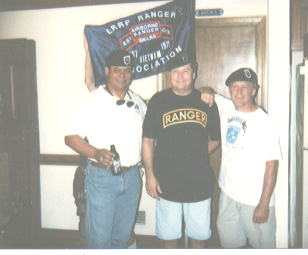|
"Rattlers in the Water"
by John "Gunner" Starnes
|
 |
|
L/R: John Starnes, Ben Thomas,
and Steve Franklin |
During a get together in Powhatan, Virginia; Rangers Ben
Thomas "Sparrow", Steve Franklin "Bubbles", and John
Starnes "Gunner", had settled down for the evening with
beers, looking at old war pictures from their 1968-1969
scrapbooks when they were in Vietnam with the Company.
Gunner showed a picture of students in Recondo School
carrying a rubber boat into the South China Sea at Chu Lai
Beach. Both Ben and Steve didn't remember the rubber boats
in the company. The boats were stored under the
commo shack. The company had one RB-15 and four RB-7s as
well as two stolen lifeguard surfboards and a couple of
duece-and-a-half inner tubes.
Anyway, the POI for waterborne training was the same as
Ranger School: one Coxswain at the aft shouting orders to
the starboard and leeward sides paddling with oars. LBE,
rucks, and weapons in the boats with the M-60 machine gun
and machine gunner at the prone forward on the bulkhead.
The M-60 was secured on a nylon rope and snap link. We
were taught service and function, inflation-deflation,
then rigging. We performed high carry and low carry,
loading, capsizing drills, paddling and maneuvering,
beaching, camouflage and storage.
The swim test was also incorporated into the training.
This was done by ordering us to swim away from the boats
for 25 meters (with boots on), and then return to the
boats. Very few of us inserted by water using the rubber
boats, perhaps due to the proven air insertion method of
the helicopters and rope insertion including extraction,
which was quicker and got everybody in and out of a hot
AO.
The other insertion methods were vehicular, foot, and
stay-behinds. These were used when the objectives were
closer than the requirements of an air insertion.
Insertion by parachute was left alone for obvious reasons.
If you donıt know why, ask the French 6th Colonial
(Parachute) Battalion who jumped in Tu Le, Vietnam!
On a personal note (not to stray away too far from the
subject), I remember what saltwater feels like on
lower-back ruck burns. The Americal Recondo Instructors
knew it would sting, but they also knew the saltwater
would help heal our ruck burns and quarter size blisters
on our feet. SP4 "Roach" Wolch captured rubber boat
training on 8mm film as shown on the video "Who Were We."
The film shows some of the LRRPs in the Company
I recall SP4 "Muscles" Bladwin; one of the soldiers
sitting on the RB-15 in preparation to paddle away on a
heavy team mission. I also know that the RB-7 was used on
one occasion to insert during the hours of darkness at the
Batangan Peninsula, located some 10-12 miles down the
beach. The team was, perhaps, "Team Lucky Strike" or "Pall
Mall".
So, what does it matter now? Maybe not much, but for a
special missions unit
such as LRRPs, it is its history that speaks of its
elite soldiersı deeds. More so, it depicts the Divisionıs
Long Range Patrol Company demonstration water insertion.
On another note, Sergeant Richard Lett was a qualified
scuba diving instructor. We had the personnel and
capability to train teams using that aspect of insertion
should there be the need. Our ties with the USMC 1st
(Force Reconnaissance) Company, who trained with s in
January-February 1968, was located just north of us. They,
too, would have helped with our scuba training for this
kind of mission.
Todayıs Rangers of E Company (Long Range Surveillance)
51st Infantry (Airborne), continue this infiltration
technique. As our aviation fly boys used to say, "Rattlers
on the Ground. How copy, over?" Well, everybody knows all
snakes swim. "Rattlers in the water, break-out."
|